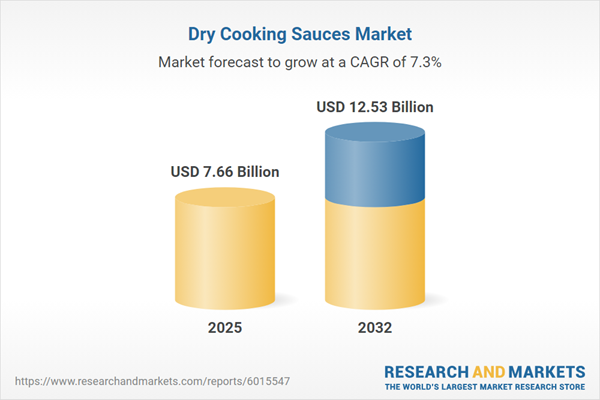Speak directly to the analyst to clarify any post sales queries you may have.
The dry cooking sauces market is navigating dynamic transformation as organizations address modern consumer needs, optimize supply resilience, and adapt digitally. Senior executives require strategic, data-backed intelligence to confidently shape future-focused decisions in this evolving environment.
Market Snapshot: Dry Cooking Sauces Market Growth and Dynamics
The global dry cooking sauces market grew from USD 7.13 billion in 2024 to USD 7.66 billion in 2025, with a projected CAGR of 7.29%. This growth is underpinned by consumers’ increased interest in superior product quality, health-oriented formulations, clear transparency, and enhanced digital experiences. Companies see heightened demand for flexible supply strategies, continuous innovation, and optimization across the full value chain. As digital commerce gains prevalence and brands elevate direct engagement, competition intensifies throughout all tiers—from product inception to distribution. Strategic decision-making now hinges on interpreting these interlocking trends and deploying resources to capture both consumer trust and operational efficiency.
Scope & Segmentation
This report provides in-depth analysis for senior decision-makers committed to advancing in the dry cooking sauces sector. The segmentation framework supports benchmarking, market positioning, and tailored responses to rapidly shifting dynamics across all critical business levers:
- End Users: Foodservice operators pursue operational streamlining, while household consumers prioritize ease and convenience. Both influence how producers develop, portion, and customize product offerings to fit contemporary preparation needs.
- Distribution Channels: The analysis reviews convenience stores, online direct-to-consumer outlets, e-marketplaces, subscription models, specialty retail, supermarkets, and hypermarkets. Organizations gain clarity on channel strategies aligned with changing buyer behaviors and evolving fulfillment requirements.
- Product Forms: Segments include concentrates, pastes, and powders—ranging from commercial to at-home uses—to provide versatility in meal preparation and address diverse eating habits.
- Packaging Types: Bottles, jars, pouches, and sachets are evaluated for their sustainability, accuracy in portioning, logistical handling, and compliance with packaging regulations, supporting optimized product delivery.
- Sauce Type Variations: The coverage extends to signature BBQ blends, international curry options, classic pasta sauces, and stir-fry solutions, supporting both regional consumption patterns and global flavor trends.
- Regional Coverage: Reported geographies include the Americas, Europe, Middle East & Africa, and Asia-Pacific. The analysis addresses region-specific purchasing factors, retail ecosystems, and rates of digital commerce adoption, empowering locally attuned strategies.
- Notable Players Assessed: Companies such as McCormick & Company, Ajinomoto Co., Inc., Nestlé S.A., Conagra Brands, General Mills, Unilever PLC, The Kraft Heinz Company, Dr. Oetker GmbH, Kerry Group, and Hormel Foods Corporation are evaluated for their market approaches, strategic priorities, and positioning.
Key Takeaways for Market Leaders
- Clear labeling practices, trusted ingredient sourcing, and robust allergy management build consumer and customer confidence while supporting compliance with increasingly stringent standards.
- Digital adoption—such as interactive recipes and social engagement—enables companies to drive retention across foodservice and retail, maximizing both brand value and customer experience.
- An omni-channel distribution approach, incorporating direct-to-consumer and subscription services, increases market penetration and strengthens overall loyalty among diverse end-user groups.
- By enhancing supply chain agility and forging partnerships with local stakeholders, companies can respond promptly to supply uncertainties and cost shifts, reducing risks and maintaining stable operations.
- Strategic collaborations across the value chain not only foster continuous product innovation but also provide operational stability in disruptive market conditions.
- Region-specific strategies, tuned to digital acumen and local flavor preferences, maximize relevance at every customer touchpoint, supporting sustainable competitive advantage.
Tariff Impact: Navigating the 2025 U.S. Tariff Environment
Impending U.S. tariffs affecting critical dry sauce ingredients are leading manufacturers to rebuild sourcing networks and reinforce supply structures. Companies are partnering with domestic input suppliers, adapting formulations for local ingredient availability, and leveraging predictive technology to mitigate regulatory and cost risk. These initiatives help maintain consistency, enhance cost management, and secure ongoing market participation as the policy landscape evolves.
Methodology & Data Sources
This report synthesizes research from regulatory filings, secondary databases, executive-level interviews, and direct end-user surveys. Insights are triangulated and validated by external experts to ensure actionable, trustworthy guidance for senior leaders seeking robust market intelligence.
Why This Report Matters to Senior Decision-Makers
- Examines the combined influence of emerging consumer trends, regulatory shifts, and digital transformation on the dry cooking sauces market, enabling leadership to anticipate change and plan with greater certainty.
- Identifies strategic segmentation opportunities that support optimization of supply chains, distribution models, and product development processes for measurable business impact.
- Empowers organizations to benchmark their strategies against industry front-runners, supporting the design of stronger and more resilient responses in a rapidly changing commercial environment.
Conclusion
Senior teams will benefit from actionable insights outlined in this report, enabling resilience, informed product innovation, and targeted growth across the dry cooking sauces supply chain.
Additional Product Information:
- Purchase of this report includes 1 year online access with quarterly updates.
- This report can be updated on request. Please contact our Customer Experience team using the Ask a Question widget on our website.
Table of Contents
3. Executive Summary
4. Market Overview
7. Cumulative Impact of Artificial Intelligence 2025
Companies Mentioned
The companies profiled in this Dry Cooking Sauces market report include:- McCormick & Company, Incorporated
- Ajinomoto Co., Inc.
- Nestlé S.A.
- Conagra Brands, Inc.
- General Mills, Inc.
- Unilever PLC
- The Kraft Heinz Company
- Dr. Oetker GmbH
- Kerry Group plc
- Hormel Foods Corporation
Table Information
| Report Attribute | Details |
|---|---|
| No. of Pages | 194 |
| Published | October 2025 |
| Forecast Period | 2025 - 2032 |
| Estimated Market Value ( USD | $ 7.66 Billion |
| Forecasted Market Value ( USD | $ 12.53 Billion |
| Compound Annual Growth Rate | 7.2% |
| Regions Covered | Global |
| No. of Companies Mentioned | 11 |









